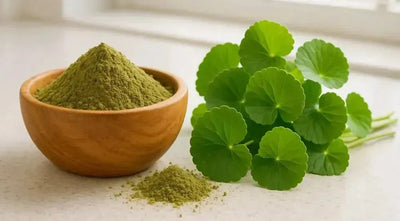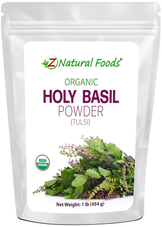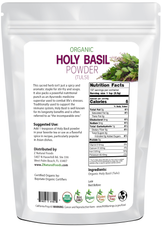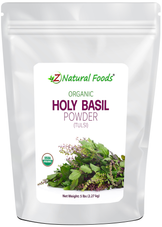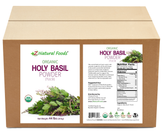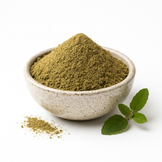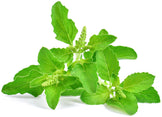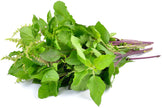Description
Ingredients
Description
Holy basil (Ocimum tenuiflorum), known as tulsi in the Hindi Language, is a green leafy plant native to Southeast Asia harvested for its possible numerous health benefits (1). Of all the herbs used within Ayurveda, tulsi stands out for its use as a possible antibiotic and natural healer.
Not only is Tulsi revered in Hinduism for its spiritual properties, but it's also preeminent in the ancient medicinal practice of Ayurveda (2).
Known as "the matchless one" or "the incomparable one," this herb is not your ordinary basil. Traditionally, tulsi has been used to support the immune system, and was even once used to support snake bites and scorpion stings (3).
As Tulsi traveled west via ancient trade routes from the Indian subcontinent to Europe, it became known to Christians as “holy basil” and found use in religious offerings and worship rituals (4). Tulsi was also used to support a healthy stress response, manage and treat hypoglycemia, and nourish the mind and elevate the spirit in Greek and Roman systems of medicine.
Modern science classifies tulsi as an adaptogenic herb and reinforces ancient Ayurvedic wisdom that long considered tulsi as a healing tonic for the mind, body, and spirit (2).
Tulsi for Healthy Conscious Living
Despite the many wonders of the 21st century, modern life is fraught with illness and stress. From its leaves, flowers, and twigs to its seeds, tulsi may be the answer to many modern ailments. Research supports the use of holy basil both for its therapeutic and nutritional value (5), considering it is a source of:
- Calcium
- Vitamin A and C
- Zinc
- Phosphorous
- Iron and
- Chlorophyll
Tulsi is considered the “Queen of herbs” for a good reason. Mounting scientific evidence finds that holy basil may protect organs and tissues from industrial pollutants and heavy metals (6). In this way, tulsi may be an ancient solution to some modern problems, considering the many toxins we are exposed to in modern-day life.
In addition, contemporary agriculture has burdened humanity with increasing exposure to unhealthy processed foods cultivated using a plethora of pesticides and other toxic industrial chemicals. Organic holy basil can be used to offset toxic exposure.
Organic Holy Basil: A Potent Adaptogen
Holy basil was traditionally used in a wide range of health-promoting ways, including:(6)
- Adaptogenic
- Anti-arthritic
- Anti-coagulant
- Anti-diabetic
- Anti-inflammatory
- Antimicrobial (including antibacterial, antifungal, and antiviral)
- Antioxidant
- Cardio-protective agent, and
- Neuro-protective
Tulsi is a herb enriched with phytochemicals, minerals, and vitamins, making it the “Mother Medicine of Nature” (6) (7). Holy basil is indeed the miracle herb of the modern age.
Since holy basil is a potent Adaptogen, it may help:
- Balance cortisol (the stress hormone) levels in the body
- Improve brain function
- Boost the immune system
- Lower inflammation
- Improve energy levels
Other Modern Uses of Organic Holy Basil
Holy basil has a vibrant and fanciful history stretching from the Vedic age to the Greek and Roman Era. Its pre-eminence in modern times is a testament to the potency of its healing properties. In modern times, holy basil has been used to:
1. Support healthy blood sugar levels
If you’re pre-diabetic or have type 2 diabetes, adding holy basil to your culinary arsenal may help support healthy blood sugar levels (8). Tulsi may also be beneficial for symptoms of diabetes such as excess insulin in the blood, insulin resistance, hypertension, weight gain, and high cholesterol (9).
2. Reduce stress and anxiety
The holy basil plant is a powerful Adaptogen (10). Adaptogenic plants help boost the body's resilience to every type of stress, whether physical, emotional, or chemical.
Studies have found that holy basil has pharmacological properties that may help you cope with stress, anxiety, and exhaustion. People who incorporated holy basil into their diets reported feeling less anxious, stressed, depressed, and fatigued (11). Holy basil is a therapeutic herb that may work wonders for your mental and emotional wellbeing.
3. Protect against infections and treat wounds
As mentioned, holy basil has potent antimicrobial and anti-inflammatory properties which may help wound healing. Holy basil has been traditionally used for mouth ulcers, raised scars, keloids, and acne (6) (11).
Holy basil also may have anti-inflammatory properties that may help people with arthritis and fibromyalgia to manage pain, swelling, and inflammation.
Adding Holy Basil to Your Daily Health Routine
Holy basil may boost physical and mental health in a variety of ways. It may help fight infection, may support healthy blood sugar and may support healthy cholesterol levels and ease pain.
So, how can you incorporate this miracle herb into your daily life? For one, organic holy basil sourced from unpolluted environments makes a great addition to your pantry. Tulsi is a great addition to recipes in its powdered form and can be used to make freshly brewed holy basil tea.
Holy basil produces no known adverse side effects. It’s no wonder this herb has been cherished for generations.
For Bulk inquiries and custom formulations click here: https://www.znaturalfoods.com/pages/bulk
For more information or to order Organic Holy Basil (Tulsi), please visit the Z Natural Foods store here.
References
- “Ocimum tenuiflorum." Germplasm Resources Information Network (GRIN). Agricultural Research Service (ARS), United States Department of Agriculture (USDA). Retrieved 12 July 2021.
- Pandey, G., & Madhuri, S. (2010). Pharmacological activities of Ocimum sanctum (tulsi): a review. Int J Pharm Sci Rev Res, 5(1), 61-66.
- Simoons, Frederick J. (1998). Plants of life, plants of death. Univ of Wisconsin Press. pp. 7–40.
- Ploss, Carl. The Holy Herb Basil. Prometheus Trust. Retrieved 12 July 2021.
- Pattanayak, P., Behera, P., Das, D., & Panda, S. K. (2010). Ocimum sanctum Linn. A reservoir plant for therapeutic applications: An overview. Pharmacognosy Reviews, 4(7), 95.
- Cohen, M. M. (2014). Tulsi-Ocimum sanctum: A herb for all reasons. Journal of Ayurveda and integrative medicine, 5(4), 251.
- Mohan, L., Amberkar, M. V., & Kumari, M. (2011). Ocimum sanctum linn.(TULSI)-an overview. Int J Pharm Sci Rev Res, 7(1), 51-53.
- Kumar, V., Andola, H. C., Lohani, H., & Chauhan, N. (2011). Pharmacological review on Ocimum sanctum Linnaeus: a queen of herbs. J of Pharm Res, 4, 366-368.
- Vats, V., Yadav, S. P., & Grover, J. K. (2004). Ethanolic extract of Ocimum sanctum leaves partially attenuates streptozotocin-induced alterations in glycogen content and carbohydrate metabolism in rats. Journal of ethnopharmacology, 90(1), 155-160.
- Prakash, P. A. G. N., & Gupta, N. (2005). Therapeutic uses of Ocimum sanctum Linn (Tulsi) with a note on eugenol and its pharmacological actions: a short review. Indian journal of physiology and pharmacology, 49(2), 125.
- Jamshidi, N., & Cohen, M. M. (2017). The clinical efficacy and safety of Tulsi in humans: a systematic review of the literature. Evidence-Based Complementary and Alternative Medicine, 2017.

